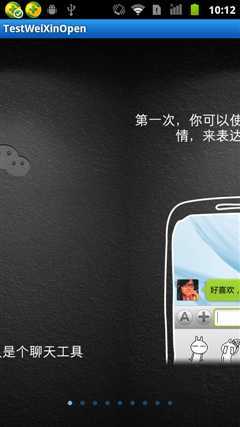标签:android style blog class code java
参考资料:http://blog.csdn.net/vipzjyno1/article/details/24592591 非常感谢这个兄弟!
在android学习中,动作交互是软件中重要的一部分,其中的Scroller就是提供了拖动效果的类,在网上,比如说一些Launcher实现滑屏都可以通过这个类去实现。。
先来看一下demo的效果: 下载地址

学习Scroller这个类之前你需要学习一下下面的知识:
1、Scroller的2个方法scrollTo()和scrollBy()不了解的点这里 scrollTo()和scrollBy()的区别 知道的跳过这一步
2、屏幕中的触摸事件分发机制(这一块在涉及到触摸的任何情况下都十分重要)现在自行百度吧,我还没有整理好关于事件分发的资料,后续我会整理一篇。
下面看一下这个类的概述:
This class encapsulates scrolling. You can use scrollers (Scroller or OverScroller) to collect the data you need to produce
a scrolling animation—for example, in response to a fling gesture. Scrollers
track scroll offsets for you over time, but they don‘t automatically apply those
positions to your view. It‘s your responsibility to get and apply new
coordinates at a rate that will make the scrolling animation look smooth.
To track the changing positions of the x/y coordinates, use computeScrollOffset(). The method returns a boolean
to indicate whether the scroller is finished. If it isn‘t, it means that a fling
or programmatic pan operation is still in progress. You can use this method to
find the current offsets of the x and y coordinates, for example:
跟踪变化的x / y坐标的位置,通过computeScrollOffset()方法监听返回的布尔值来指示滚动动作是否完成。如果返回为false,说明滚动已经结束。返回true,它意味着操作仍在进行中。您可以使用
int currX = mScroller.getCurrX(); //滚动的X滚动距离
int currY = mScroller.getCurrY(); //滚动的y滚动距离
这个方法来找到当前的x和y坐标的偏移量。
在看一下构造函数
| Public Constructors | |||||||||||
|---|---|---|---|---|---|---|---|---|---|---|---|
|
Create a Scroller with the default duration and interpolator.
| |||||||||||
|
Create a Scroller with the specified interpolator. | |||||||||||
|
Create a Scroller with the specified interpolator. | |||||||||||
Interpolator interpolator 表示的是动画插入器,你可以设定相应的效果给它。
下面是所有的插入器
AccelerateDecelerateInterpolator 动画效果:开始和结束都是缓慢的,通过中间时候加速
AccelerateInterpolator, 动画效果:开始缓慢,之后加速
AnticipateInterpolator, 动画效果:开始后退,然后前进
AnticipateOvershootInterpolator, 动画效果:开始后退,之后前进并超过终点位置,最终退回到终点
BounceInterpolator, 动画效果:慢慢反弹到,弹性衰减到结束
CycleInterpolator, 动画效果:重复循环动画,速度变化遵循正弦定律
DecelerateInterpolator, 动画效果:刚开始快速,之后减速
LinearInterpolator, 动画效果:不断的变化
OvershootInterpolator 动画效果:像前超越最终点然后回来
可以通过初始化构造方法Scroller(Context context, Interpolator interpolator)给它相应的动画效果。
Interpolator interpolator = new BounceInterpolator();
在看一下他的公用方法:
| blic Methods | |||||||||||
|---|---|---|---|---|---|---|---|---|---|---|---|
|
void |
abortAnimation()
停止动画,滚到最终的x,y位置中止动画 | ||||||||||
|
boolean |
computeScrollOffset()
当你想要知道新的位置时候,调用该方法。返回true:动画没结束 | ||||||||||
|
void |
extendDuration(int extend)
延长滚动动画的时间。extend表示延迟时间(单位为毫秒) | ||||||||||
|
void |
fling(int startX, int startY, int velocityX, int
velocityY, int minX, int maxX, int minY, int maxY)
在fling(快速滑动,触摸屏幕后快意移动松开)的手势基础上开始滚动,滚动距离取决于fling的初速度。 | ||||||||||
|
final void |
forceFinished(boolean finished) 强制终止滚动。
| ||||||||||
|
float |
getCurrVelocity() 返回当前的速度 | ||||||||||
|
final int |
getCurrX()
返回当前滚动的X方向的偏移量(距离原点X轴方向) | ||||||||||
|
final int |
getCurrY()
返回当前滚动的Y方向的偏移量(距离原点Y轴方向) | ||||||||||
|
final int |
getDuration() 返回滚动事件的持续时间(毫秒) | ||||||||||
|
final int |
getFinalX() 返回滚动结束的X方向的偏移量(注:只针对fling
手势有效)(距离原点X轴方向) | ||||||||||
|
final int |
getFinalY()
返回滚动结束的Y方向的偏移量(注:只针对fling 手势有效)(距离原点Y轴方向) | ||||||||||
|
final int |
getStartX()
返回滚动起始点的X方向偏移量(距离原点X轴方向) | ||||||||||
|
final int |
|||||||||||
|
final boolean |
isFinished()
返回scroller滚动是否结束,true:滚动结束 false:还在滚动 |
||||||||||
|
void |
setFinalX(int newX)
设置scroller的终止时X方向偏移量 | ||||||||||
|
void |
|||||||||||
|
final void |
setFriction(float friction)
The amount of friction applied to flings. | ||||||||||
|
void |
startScroll(int startX, int startY, int dx, int
dy)
提供起始点和滚动距离,调用该方法进行滚动。(此处默认时间为250ms) | ||||||||||
|
void |
startScroll(int startX, int startY, int dx, int dy,
int duration)
提供起始点和滚动距离以及滚动时间,调用该方法进行滚动。 | ||||||||||
|
int |
timePassed() 返回自滚动开始经过的时间(毫秒) | ||||||||||
下面看看以上方法的源码实现:
1 /** 2 * Call this when you want to know the new location. If it returns true, 3 * the animation is not yet finished. loc will be altered to provide the 4 * new location. 5 */ 6 public boolean computeScrollOffset() { 7 if (mFinished) { 8 return false; //已经完成了本次动画,直接返回为false 9 } 10 int timePassed = (int)(AnimationUtils.currentAnimationTimeMillis() - mStartTime); 11 12 if (timePassed < mDuration) { 13 switch (mMode) { 14 case SCROLL_MODE: 15 float x = timePassed * mDurationReciprocal; 16 17 if (mInterpolator == null) 18 x = viscousFluid(x); 19 else 20 x = mInterpolator.getInterpolation(x); 21 22 mCurrX = mStartX + Math.round(x * mDeltaX); 23 mCurrY = mStartY + Math.round(x * mDeltaY); 24 break; 25 case FLING_MODE: 26 final float t = (float) timePassed / mDuration; 27 final int index = (int) (NB_SAMPLES * t); 28 float distanceCoef = 1.f; 29 float velocityCoef = 0.f; 30 if (index < NB_SAMPLES) { 31 final float t_inf = (float) index / NB_SAMPLES; 32 final float t_sup = (float) (index + 1) / NB_SAMPLES; 33 final float d_inf = SPLINE_POSITION[index]; 34 final float d_sup = SPLINE_POSITION[index + 1]; 35 velocityCoef = (d_sup - d_inf) / (t_sup - t_inf); 36 distanceCoef = d_inf + (t - t_inf) * velocityCoef; 37 } 38 mCurrVelocity = velocityCoef * mDistance / mDuration * 1000.0f; 39 40 mCurrX = mStartX + Math.round(distanceCoef * (mFinalX - mStartX)); 41 // Pin to mMinX <= mCurrX <= mMaxX 42 mCurrX = Math.min(mCurrX, mMaxX); 43 mCurrX = Math.max(mCurrX, mMinX); 44 45 mCurrY = mStartY + Math.round(distanceCoef * (mFinalY - mStartY)); 46 // Pin to mMinY <= mCurrY <= mMaxY 47 mCurrY = Math.min(mCurrY, mMaxY); 48 mCurrY = Math.max(mCurrY, mMinY); 49 if (mCurrX == mFinalX && mCurrY == mFinalY) { 50 mFinished = true; 51 } 52 break; 53 } 54 } 55 else { 56 mCurrX = mFinalX; 57 mCurrY = mFinalY; 58 mFinished = true; 59 } 60 return true; 61 }
调用该方法判断滚动是否还在继续,mFinished属性判断是否滚动完成,如果滚动完成了,mFinished = true,computeScrollOffset() 返回false。
1 /** 2 * Called by a parent to request that a child update its values for mScrollX 3 * and mScrollY if necessary. This will typically be done if the child is 4 * animating a scroll using a {@link android.widget.Scroller Scroller} 5 * object. 6 */由父视图调用用来请求子视图根据偏移值 mScrollX,mScrollY重新绘制 7 public void computeScroll() { 8 }
知道了computeScrollOffset()这个判断是否滚动的方法,那我们必须要有监听滑屏控制,并且重绘,在Android框架中的VIEW类中就提供了computeScroll()这个方法去控制该流程。在绘制View时,会在draw()过程调用该方法。因此, 再配合使用Scroller实例,我们就可以获得当前应该的偏移坐标,手动使View/ViewGroup偏移至该处。
注:在使用Scroller这个类实现偏移控制,一般自定义View/ViewGroup都需要重载该方法 。
具体实现:
1 @Override 2 public void computeScroll() { 3 if (mScroller.computeScrollOffset()) { 4 scrollTo(mScroller.getCurrX(), mScroller.getCurrY()); 5 // 更新界面 6 postInvalidate(); 7 isMoving = true; 8 } else { 9 isMoving = false; 10 } 11 super.computeScroll(); 12 }
1 /** 2 * Start scrolling by providing a starting point and the distance to travel. 3 * 4 * @param startX //水平方向滚动的偏移值,以像素为单位。正值表明滚动将向左滚动 5 * @param startY //垂直方向滚动的偏移值,以像素为单位。正值表明滚动将向上滚动 6 * @param dx //水平方向滑动的距离,正值会使滚动向左滚动 7 * @param dy //垂直方向滑动的距离,正值会使滚动向上滚动 8 * @param duration //滚动持续时间 9 */ 10 public void startScroll(int startX, int startY, int dx, int dy, int duration) { 11 mMode = SCROLL_MODE; 12 mFinished = false; 13 mDuration = duration; 14 mStartTime = AnimationUtils.currentAnimationTimeMillis(); 15 mStartX = startX; 16 mStartY = startY; 17 mFinalX = startX + dx; 18 mFinalY = startY + dy; 19 mDeltaX = dx; 20 mDeltaY = dy; 21 mDurationReciprocal = 1.0f / (float) mDuration; 22 }
该方法以提供的起始点和将要滑动的距离开始滚动,我们可以使用该方法达到自动滚动的效果。在滚动中,如果符合什么条件,可以调用该方法让它滚动到相对应的地方。
在界面滚动中,你必须搞清楚和scrollTo和scrollBy之间的区别所在:android 布局之滑动探究 scrollTo 和 scrollBy 方法使用说明

如果你使用Scroller,流程如下:
1.可以在自定义的布局中,按照需求初始化Scroller构造函数。
2.重写onInterceptTouchEvent(MotionEvent ev)方法,看看是否要拦截相关的点击时间。
3.重写onTouchEvent(MotionEvent event)方法,根据触摸屏上的动作使用computeScroll()以及scrollTo 和 scrollBy 方法进行根据手指对布局进行滑动效果。
4.在触摸操作结束(MotionEvent.ACTION_UP)的时候,调用startScroll(int startX, int startY, int dx, int dy, int duration)方法,进行动画自动操作,来完成整个滚动流程。
对于Scroller类大体的使用和介绍已经完毕,结合上面介绍的这些看一下上面的demo我相信你的收获一定很大的。这东西虽然都不是我写的,但是都是我读懂之后才放上来的,1是为了给大家分享一下,2就是我自己的笔记。
[学习总结]3、Android---Scroller类(左右滑动效果常用的类),布布扣,bubuko.com
[学习总结]3、Android---Scroller类(左右滑动效果常用的类)
标签:android style blog class code java
原文地址:http://www.cnblogs.com/androidxiaoyang/p/3718350.html